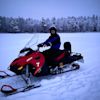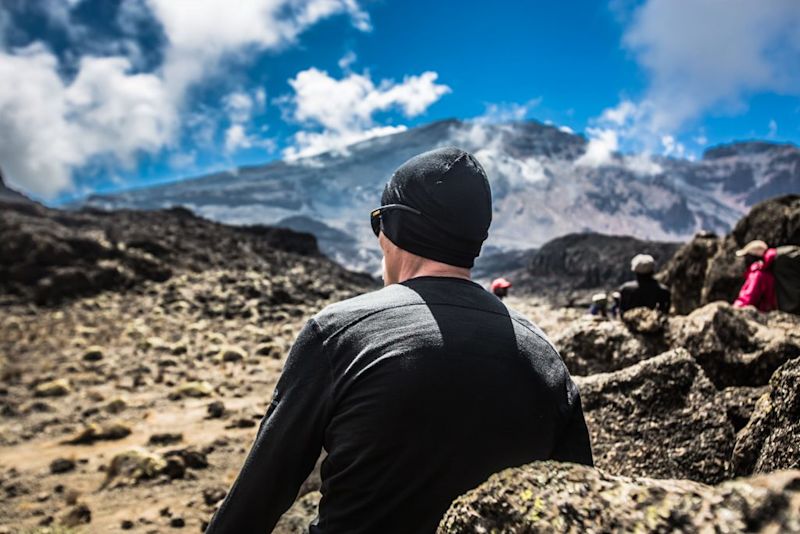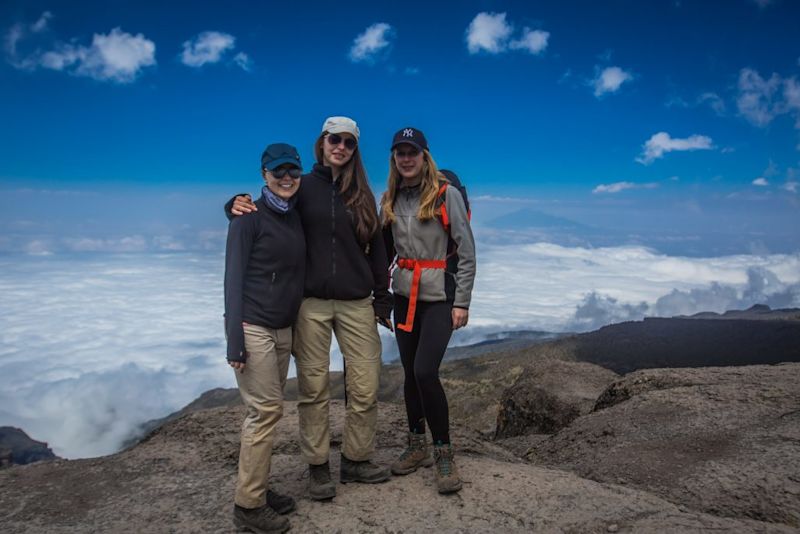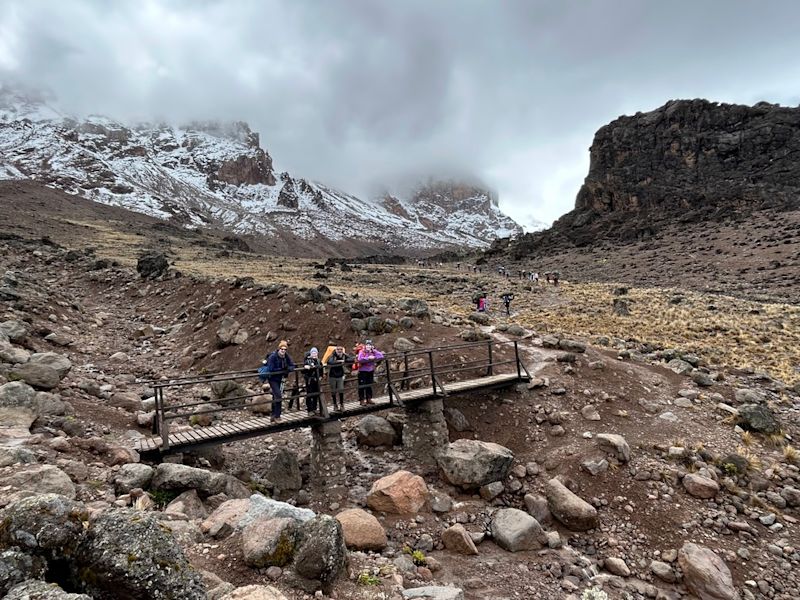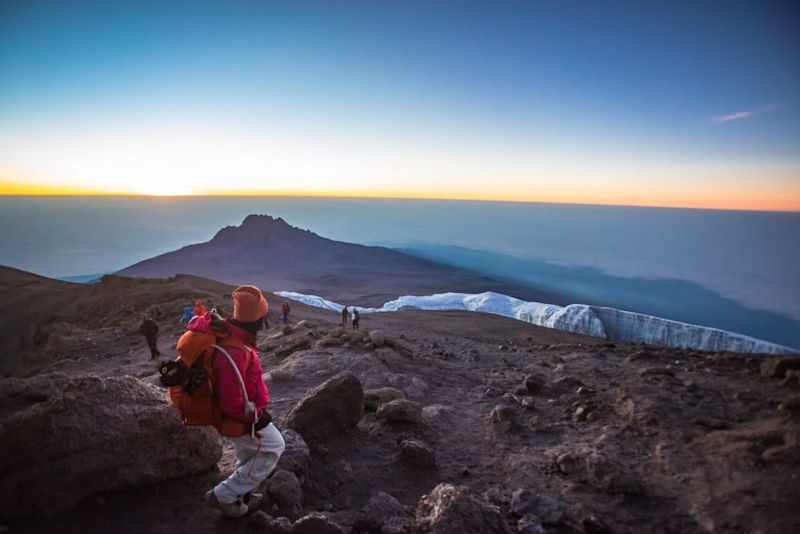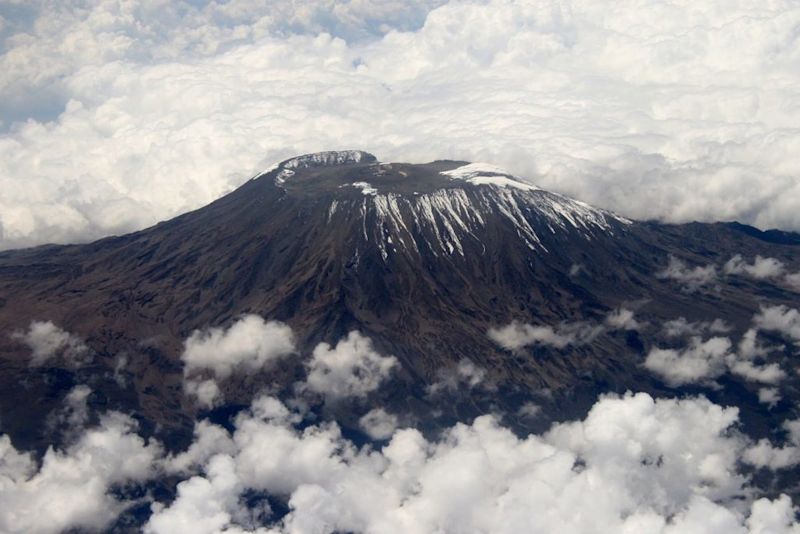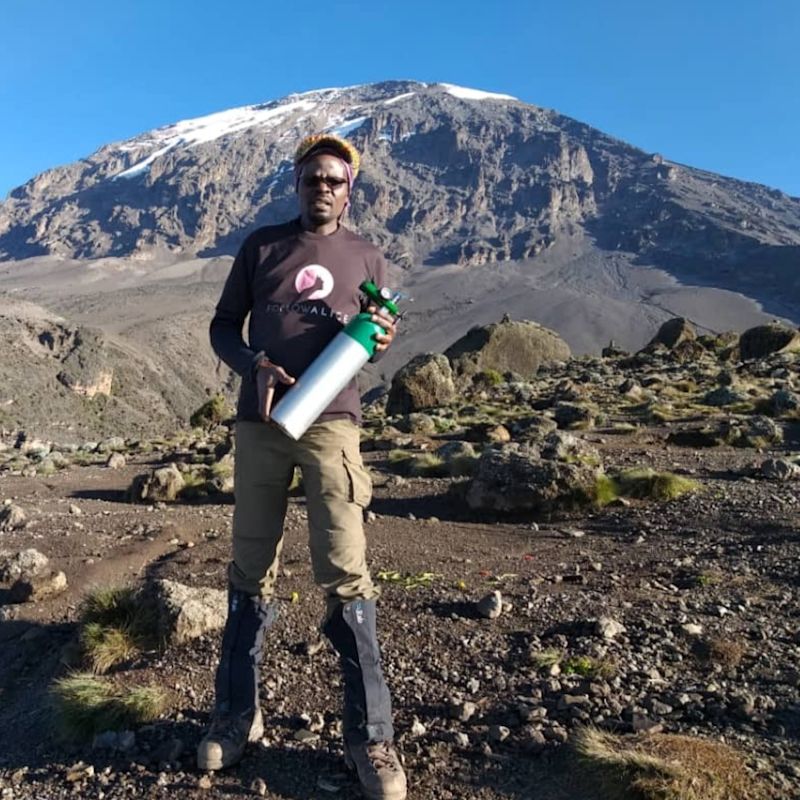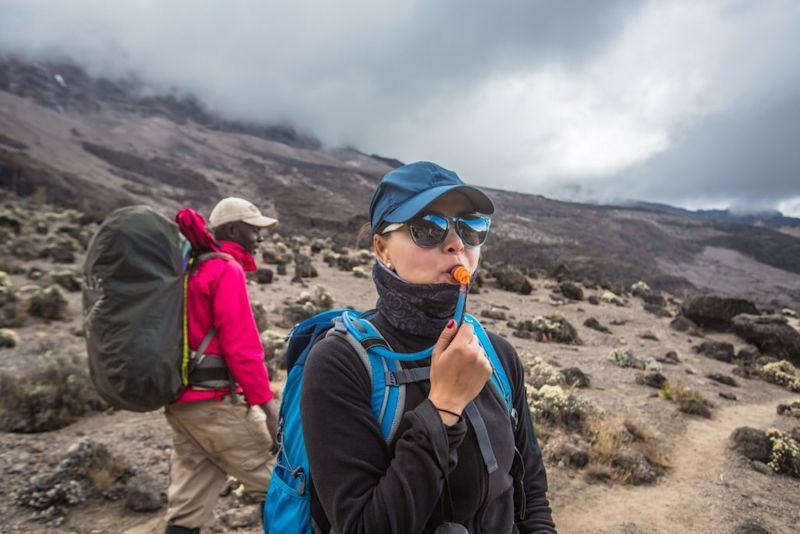We've permission to use the image above from the talented photographer Tristan.
Let's look at what causes altitude sickness, its symptoms, and how to avoid and treat it. We also discuss the emergency procedures that are followed in cases of extreme altitude sickness.
What is altitude sickness?
Often folks attempting to climb Kilimanjaro make the mistake of hiking too high too quickly. They then develop altitude sickness, which is the body struggling and reacting badly to being made to operate on less oxygen.
Why less oxygen?
The reduced air pressure at higher elevations means that the number of oxygen molecules you can take in per breath is reduced. At 3,600 m (12,000 ft), for instance, there's roughly 40% fewer oxygen molecules per breath than at sea level.
By the time you reach the summit of Kilimanjaro, you're breathing in roughly half the oxygen molecules per breath than you would at sea level!
Less oxygen per breath places a strain on your body, especially when you're exerting yourself. And when you make a sizeable and speedy jump in elevation, the strain can be intense.
This why you want to ascend Kilimanjaro slowly – to give your body ample time to adjust to the increasing strain of a reduced oxygen intake that comes with each's day ascent.
Note that the development of altitude sickness depends upon elevation, rate of ascent, and individual susceptibility. What this means is that everyone acclimatises at different rates. So nobody can predict how each person will react to the elevation gains you achieve each day on a Kilimanjaro climb.
For this reason, it's best to play it safe and ascend Kilimanjaro slowly. We recommend doing an eight- or nine-day climb, as this gives you seven or eight days respectively to reach the summit. For most people, this rate of ascent is slow enough for the body to adjust reasonably well to the ever-increasing altitude.
We suggest that you allow at least six days – seven is better – for your Kilimanjaro ascent to play it safe.
What is acute mountain sickness?
Some of you might have heard the term acute mountain sickness (AMS) bandied about. This is simply another term for the mildest version of altitude sickness.
AMS is not serious in and of itself, but it's important to monitor the symptoms to ensure it doesn't develop into a more severe form of altitude sickness.
What are the symptoms of altitude sickness?
We can classify the symptoms of altitude sickness into two camps:
- Mild symptoms
- Severe symptoms
Mild symptoms
Mild symptoms of altitude sickness indicate that you've developed acute mountain sickness (AMS), which as mentioned is the mildest form of altitude sickness.
AMS can be likened to experiencing a bad hangover. Its symptoms are generally worse at night when your respiratory drive is decreased.
AMS symptoms include:
- headaches
- fitful sleep or insomnia
- vivid dreams
- fatigue
- shortness of breath with physical exertion
- dizziness
- loss of appetite
- nausea and vomiting
- irritability
- muscle aches
- swelling of the hands, feet and face
- a rapid heartbeat
Most climbers develop AMS in the moorland or alpine desert sections
Severe symptoms
It's very rare that a climber will experience anything more than AMS on a Kilimanjaro climb.
However, it's important for your Kilimanjaro safety that you're aware of what severe altitude sickness entails. Also, you need to be aware that if it's left untreated, severe altitude sickness can be fatal.
This is why we always tell our clients that it's super important to regularly communicate with your Kilimanjaro guide about how you're feeling. Never feel that you're a bother or a nuisance. Rather over-communicate about your symptoms than under-communicate about them.
If you develop a severe case of altitude sickness you may experience symptoms such as:
- wet coughing
- chest congestion
- extreme fatigue
- fast, shallow breathing
- gurgling breaths
- blue or grey lips or fingernails
- pale complexion and skin discolouration
- inability to walk or lack of balance (ataxia)
- confusion
- social withdrawal
If you travel with a reputable tour operator, your guides will be trained in detecting both mild and severe altitude sickness and will know how to respond accordingly. We talk more on this important topic of trained guides a little later on.
Mild altitude sickness on Kilimanjaro is normal
It's perfectly normal to get mild altitude sickness on Kilimanjaro. As mentioned, mild altitude sickness is also known as acute mountain sickness (AMS).
AMS isn't serious – it's just unpleasant.
Note that even if you give yourself enough days for the ascent up Kilimanjaro, and are therefore doing the climb safely, the chances are good that you'll still develop AMS. In fact, once you climb above 3,000 metres, more than 75% of Kilimanjaro climbers develop AMS.
Note that age, sex or physical fitness have no link to your likelihood of getting altitude sickness. And just because you haven't had it before doesn't mean you won't develop it on another trip. It's by and large something of a lottery as to who develops AMS and who doesn't.
It's therefore best, in our opinion, to prepare yourself mentally for the chance of developing AMS and to visualise pushing through the unpleasant symptoms.
More than 75% of climbers will experience mild symptoms of altitude sickness when climbing Kilimanjaro.
Severe altitude sickness is dangerous
If severe altitude sickness is ignored, it can lead to life-threatening conditions. There are two serious conditions associated with severe altitude sickness:
- High altitude pulmonary oedema (HAPE), which is a build-up of fluid in the lungs.
- High altitude cerebral oedema (HACE), which is the swelling of the brain caused by a lack of oxygen.
These conditions are very rare. But when they do occur, it's usually because you went too high too quickly, and you stayed at that height instead of immediately descending in altitude.
This is why climbers must descend the mountain promptly if their guides say they have severe mountain sickness.
You're often above the clouds on a Kilimanjaro climb
Can altitude sickness be avoided?
There's a common misconception that if you're physically fit, you're less likely to be struck by altitude sickness. But this just isn't true.
Young, old, fit, unfit – altitude sickness seems to choose its victims at random.
That said, while you can't necessarily avoid altitude sickness altogether on a Kilimanjaro climb, you can reduce its severity. The three main ways of doing this are:
- Visit your doctor and ask for acetazolamide, which can be used to treat altitude sickness and so will help you cope with the unpleasant symptoms associated with it.
- Do an acclimatisation hike like climbing Mt Meru just prior to climbing Kilimanjaro.
- Choose a Kilimanjaro route that offers a relatively gentle rate of ascent.
We discuss all of these suggestions in more detail further on in this post.
What is acclimatisation?
Acclimatisation (also sometimes called acclimating) refers to the process by which your body adjusts to a new, higher altitude. When your rate of ascent to a very high altitude (anything above 3,000 m) is too speedy, then your body struggles to acclimatise well, and develops AMS.
You therefore want to choose one of the seven Kilimanjaro ascent routes that offers a good acclimatisation profile. Please read The best acclimatisation for climbing Kilimanjaro as this explains the matter in more detail and offers route recommendations.
Note that acclimatisation generally takes one to three days at any given altitude. This is why having the right itinerary for the right Kilimanjaro route is essential.
This snap on Kilimanjaro was taken by our client Romy
How to treat mild altitude sickness
Mild symptoms of altitude sickness on Kilimanjaro are common and fairly easily treated.
Firstly, you want to rest as much as possible. You should also drink lots of water, as this helps to reduce the unpleasant symptoms of AMS. You can also take a painkiller such as paracetamol to help you cope with any pain like a headache.
The NHS recommends combatting AMS with these medicines:
- Acetazolamide (like Diamox) to prevent and treat AMS – you need a prescription for this from your doctor.
- Ibuprofen or paracetamol for treating headaches and other pains.
- Anti-nausea medication like promethazine for treating nausea.
There are also natural remedies you can try for treating mild symptoms of altitude sickness on Kilimanjaro. These include ginger, lavender oil, garlic and cloves.
Once again, please remember that AMS is to be expected on a Kilimanjaro climb. Also, it tends to subside after a day or two.
How to treat severe altitude sickness
Severe cases of altitude sickness on Kilimanjaro can only be treated by immediate descent to around 600 m (2,000 ft) or lower.
When a climber develops severe altitude sickness, your guide will give you some oxygen from the emergency oxygen canister. But it's also then time to abort your climb and descend the mountain promptly.
Please note that if your guide says you have severe altitude sickness and you must descend, then you must listen. Kilimanjaro guides know what they're talking about when it comes to this illness. And they're responsible for your health and safety.
When a climber has to descend, a guide will escort them down the mountain. If the climber can't walk, the guide and some porters will carry the ill person down the mountain on a stretcher.
At Follow Alice, we always have plenty of guides on each climb. This means that in an emergency, there are always enough guides for one to descend with the patient while everyone else continuing on the climb is still accompanied by a sufficient number of guides.
Follow Alice lead guide Chris holding an oxygen canister on Kilimanjaro
As soon as someone with severe altitude sickness is escorted down the mountain, they should head to the hospital, or at least visit a doctor. If you're a Follow Alice climber, we'll take you straight to the hospital for a checkup. If you're unable to communicate on your own, we'll keep your loved ones updated on your status.
As mentioned, it's very rare for climbers to develop life-threatening altitude sickness on a Kilimanjaro climb. If you have a good guide, they'll ensure you're acclimatising well so that the chances of you developing severe altitude sickness are extremely small.
Why you should drink lots of water on Kilimanjaro
You dehydrate faster when your breathing becomes heavy and quick. We therefore recommend a daily fluid intake of four to five litres of water on a Kilimanjaro climb.
Water improves your circulation as well as most other bodily functions. It therefore helps to alleviate the unpleasant symptoms of altitude sickness.
Check your urine during your Kilimanjaro climb to ensure you're drinking enough. Healthy urine has little odour, but if you're dehydrated, your urine is likely to smell strongly – like ammonia. It's also likely to be a darker colour than usual.
In our Kilimanjaro packing list, we describe the containers you should pack in order to carry enough water. We also recommend bringing electrolyte sachets to help keep you well hydrated.
Finally, avoid alcohol on your climb – this won't help your body adjust to the altitude at all!
Monitoring your health on Kilimanjaro
The final topic we want to discuss with you in this blog post is about monitoring your health on Kilimanjaro.
When it comes to monitoring your health (especially in terms of altitude sickness), you need two things:
- Experienced and qualified guides
- The necessary medical equipment
Experienced and qualified guides
It's imperative that you only climb Kilimanjaro with a reputable tour operator, as they will only use properly trained and experienced guides. Your guides are there to keep you safe and treat you should you become ill or injured.
At Follow Alice we prioritise your Kilimanjaro safety above everything else. All of our guides are trained wilderness first responders (WFRs), which is the highest non-medical certification available to outdoor guides. WFRs are trained to make critical medical and evacuation decisions on site.
We felt greatly taken care of by the Follow Alice crew! The guides made us feel safe at all times.
– Christoph
The necessary medical equipment
A reputable Kilimanjaro tour operator will ensure its guides have the following:
- A medical kit
- Emergency oxygen
- A stretcher
- A pulse oximeter
A pulse oximeter measures the oxygen in your blood, revealing whether or not you're acclimatising well. You should get routine checkups throughout your climb. At Follow Alice, we monitor your oxygen every day, sometimes twice a day.
If you'd like to know more on this topic of guide qualifications and medical equipment, please read How we keep you safe on Kilimanjaro.

